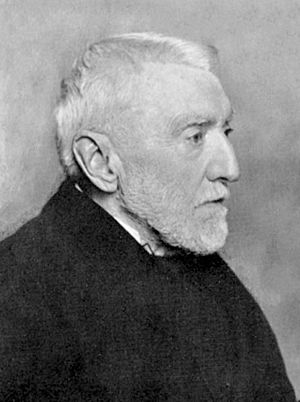Henry Faulds facts for kids
Henry Faulds (born June 1, 1843 – died March 24, 1930) was a Scottish doctor, missionary, and scientist. He is best known for helping to develop the use of fingerprints for identification.
Contents
Early Life and Studies
Henry Faulds was born in Beith, Scotland. His family wasn't rich, so he had to leave school at age 13 to work as a clerk in Glasgow. When he was 21, he decided to go back to school. He studied math and other subjects at Glasgow University. Later, he studied medicine at Anderson's College and became a doctor.
After finishing his studies, Faulds became a medical missionary for the Church of Scotland. In 1871, he went to British India and worked for two years at a hospital for poor people in Darjeeling. In 1873, he was asked to start a medical mission in Japan. He married Isabella Wilson and they moved to Japan in December of that year.
Life and Discoveries in Japan
In 1874, Faulds opened the first English-speaking mission in Japan. It included a hospital and a place to teach Japanese medical students. He taught Japanese surgeons about Joseph Lister's antiseptic methods, which are clean ways to prevent infections during surgery.
Faulds did many good things in Japan:
- In 1875, he helped start Japan's first group for the blind, called the Rakuzenkai. He also helped set up lifeguard stations to stop people from drowning in canals.
- He helped stop a rabies outbreak that was making children sick.
- He also helped control the spread of cholera.
- By 1882, his hospital in Tokyo treated 15,000 patients every year!
- Faulds learned to speak Japanese very well. Besides being a full-time doctor, he wrote books about traveling in Asia and many articles. He even started three magazines.
How Fingerprints Were Discovered
One day, Faulds was with a friend, Edward S. Morse, at an archaeological dig. He noticed the clear marks left by ancient craftspeople on old clay pieces. He then looked closely at his own fingertips and those of his friends. He became sure that the patterns of ridges on each person's fingers were unique.
Soon after, his hospital was broken into. The local police arrested a staff member, but Faulds believed the person was innocent. He compared the fingerprints left at the crime scene to those of the suspect. They were different! Because of this evidence, the police released the suspect. This showed how useful fingerprints could be.
Faulds tried to share his idea about using fingerprints to identify people. He asked Charles Darwin for help. Darwin passed the idea to his relative, Francis Galton. Faulds published his findings in the scientific journal Nature in 1880. This was the first time his ideas were shared widely.
The next month, Sir William James Herschel, a British official in India, wrote to Nature. He said he had been using fingerprints since 1860 to identify criminals. However, Herschel had not thought about using them to solve crimes, like Faulds did. There was some debate over who should get credit for the idea of using fingerprints in forensics, but Faulds' paper was definitely the first to be published on the topic.
Return to Britain
In 1886, Faulds returned to Britain after a disagreement with the missionary group that ran his hospital in Japan. He offered his idea of fingerprint identification to Scotland Yard, the police headquarters. However, they did not accept his idea at first. This was probably because he didn't have enough proof yet that fingerprints were unique, lasting, and easy to classify.
Faulds then worked as a police surgeon in London and later in Fenton. In 1922, he stopped working and moved to Wolstanton. He died in March 1930, at the age of 86. He felt sad that his work wasn't fully recognized during his lifetime.
Today, Henry Faulds is remembered. In 2007, a plaque was put up near his grave in Wolstanton. In 2011, another plaque was placed at his old home. In 2004, a memorial was dedicated to him in his hometown of Beith.
Legacy
Henry Faulds played a very important role in the development of using fingerprints to identify criminals. While others had used fingerprints for identification, Faulds was the first to suggest their use in solving crimes. His work helped lay the groundwork for Francis Galton to study fingerprints scientifically. This scientific study helped courts accept fingerprints as evidence. The Japanese police officially started using the fingerprinting system in 1911.
His hospital in Tokyo later became St. Luke's International Hospital, which is still a well-known hospital today.


